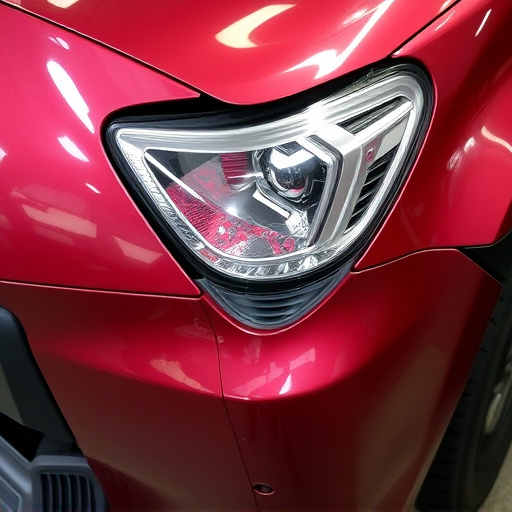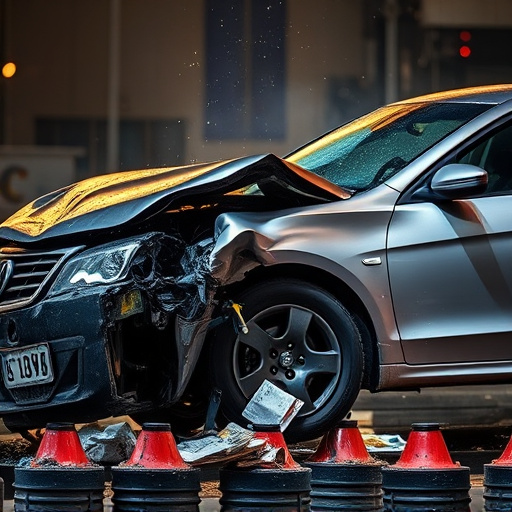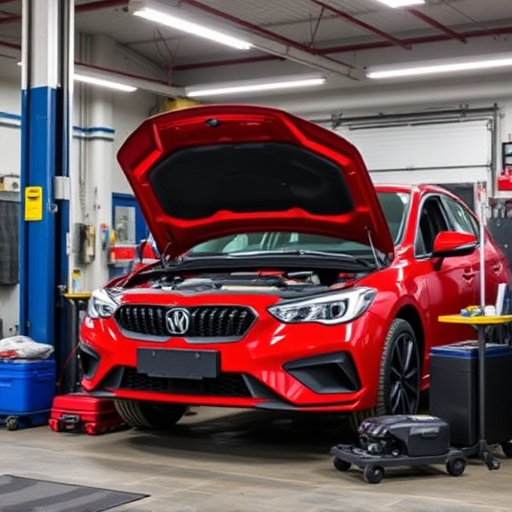Who Benefits Most From Faster Paintless Dent Repair?

Paintless dent repair time offers a cost-effective and efficient solution for car owners on a budget…….
Welcome to an in-depth exploration of a revolutionary concept in the automotive industry: Paintless Dent Repair Time. This cutting-edge technique has transformed vehicle body repair, offering faster, more cost-effective solutions without compromising quality. In this comprehensive article, we will unravel the intricacies of paintless dent repair, its global impact, and its role in shaping the future of automotive care. Get ready to dive into a world where time is money, and precision is key.
Definition: Paintless Dent Repair (PDR) is a specialized method for removing dents, dings, and creases from vehicle bodies without sanding or repainting. It focuses on restoring damaged areas to their original condition, preserving the integrity of the paintwork.
Core Components: The process involves several steps:
Inspection: Technicians carefully assess the damage, identifying the size, depth, and location of dents. This step is crucial for determining the repair approach.
Clamping: Special clamps are strategically placed around the dent to secure the panel while the repair process begins.
PDR Tools: A variety of tools, such as plastic hammers, paddles, and air guns, are utilized to gently push or pull the metal back to its original shape. This technique minimizes the risk of paint damage.
Finishing: Once the dent is removed, technicians may use polishers to smooth any remaining imperfections, ensuring a flawless finish.
Historical Context: The roots of PDR can be traced back to traditional methods used by ancient cultures to repair damaged objects. However, its modern application in vehicle restoration emerged in the 1980s, gaining popularity due to its cost-effectiveness and minimal impact on paintwork. Over time, technological advancements have refined the technique, making it faster and more accessible.
Significance: Paintless dent repair offers several advantages:
Time Efficiency: Repairs can often be completed in a fraction of the time compared to traditional painting methods, reducing downtime for vehicle owners.
Cost Savings: By eliminating the need for repainting, PDR is significantly more cost-effective, making it an attractive option for both consumers and automotive businesses.
Preservation of Paintwork: The technique maintains the original factory paint, ensuring a more authentic look and preventing potential issues with future painting.
Paintless dent repair has transcended geographical boundaries, leaving its mark on the global automotive landscape:
| Region | Impact and Trends |
|---|---|
| North America | The US and Canada have seen a rapid adoption of PDR, driven by consumer demand for quick, affordable repairs. Advanced training programs have elevated the standard of workmanship across the region. |
| Europe | European countries have embraced PDR, with Germany leading the way in technological innovation. The emphasis on precision craftsmanship has set a high bar for quality standards. |
| Asia-Pacific | This region’s growing automotive industry has fueled the demand for efficient repair methods. Japan, known for its precision engineering, has contributed to advanced PDR techniques. |
| Middle East and Africa | With an increasing number of vehicles on the road, these regions are witnessing a surge in PDR centers, offering convenient and high-quality repairs. |
These trends highlight the global recognition and acceptance of paintless dent repair as a preferred choice for vehicle restoration.
The economic implications of paintless dent repair time are significant, shaping both local and international markets:
Market Dynamics: The PDR industry is characterized by a mix of independent repair shops, franchise operations, and mobile service providers. This diversity creates competition, driving innovation and pricing strategies.
Investment Patterns: Initial investment costs for setting up a PDR center range from moderate to substantial, depending on equipment and training. However, the potential for high returns attracts investors.
Economic Impact: As a non-disruptive repair method, PDR contributes to vehicle resale value, ensuring that minor dents do not devalue assets significantly. This benefits both owners and dealers.
Technology plays a pivotal role in shaping the future of paintless dent repair time:
Digital Imaging: Advanced 3D cameras and computer-aided design (CAD) software enable precise measurements, enhancing clamping accuracy and overall repair efficiency.
Smart Tools: Newer PDR tools incorporate sensors and AI algorithms to optimize force application, minimizing damage and improving precision.
Automated Systems: Some companies are exploring automated PDR machines, promising even faster turnaround times and consistent quality.
Online Booking and Tracking: Digital platforms allow customers to book appointments, track repairs, and receive real-time updates, enhancing convenience and customer satisfaction.
These technological breakthroughs not only streamline the repair process but also elevate the overall customer experience.
The automotive industry is heavily regulated, and paintless dent repair time is no exception. Key policies and regulations include:
Safety Standards: All PDR technicians must adhere to safety protocols, ensuring their well-being and that of customers.
Warranty Considerations: Repair centers must clearly communicate warranty policies to customers, especially when dealing with manufacturer-backed warranties.
Environmental Regulations: Some regions have specific rules regarding the disposal of damaged panels and recycling materials used in the process.
Licensing and Certification: Many countries require PDR technicians to obtain specialized licenses or certifications to operate legally.
Despite its numerous advantages, paintless dent repair time faces certain challenges and criticisms:
Limited Accessibility: In remote areas, the availability of trained professionals and specialized equipment may be limited, hindering access to PDR services.
Complex Damage Scenarios: Some severe dents or damage patterns might require more extensive repairs, surpassing the capabilities of PDR.
Customer Skepticism: Despite the success of PDR, some customers remain skeptical about its effectiveness, especially with older vehicles or heavily damaged panels.
Strategic Solutions: To address these issues:
Mobile Services: Expanding mobile PDR units can bridge the gap in accessibility, bringing services to underserved areas.
Continuous Training: Providing advanced training programs can enhance technicians’ skills, ensuring they can handle a broader range of damage cases.
Public Awareness Campaigns: Educating consumers about PDR’s capabilities through marketing and social media campaigns can dispel misconceptions.
In a bustling metropolitan area, a startup PDR company transformed the local automotive landscape. By offering mobile services and utilizing advanced digital tools, they reduced repair times by 30%. Their success lay in providing convenient, high-quality repairs, attracting a loyal customer base.
A European PDR franchise expanded internationally, adopting localized strategies for each market. They trained local technicians, ensuring cultural sensitivity and language barriers were overcome. This approach led to successful operations across multiple countries, establishing them as a global leader.
The paintless dent repair time industry is poised for continued growth and innovation:
Sustainable Practices: There will be an increased focus on eco-friendly materials and processes, aligning with global sustainability goals.
Artificial Intelligence Integration: AI-driven systems could revolutionize PDR, offering precise damage assessments and personalized repair solutions.
Remote Repair Technologies: Advancements in robotics and remote control technology might enable repairs in challenging-to-reach areas.
Personalized Customer Experiences: Digital platforms will continue to enhance customer interaction, allowing for customized repair schedules and real-time updates.
Paintless dent repair time has evolved from a niche technique to a mainstream solution, shaping the future of vehicle care. Its global impact, technological advancements, and economic viability solidify its position as a critical component of the automotive industry. As we look ahead, PDR’s role in enhancing efficiency, accessibility, and customer satisfaction will only grow more profound.
Q: How long does paintless dent repair usually take?
A: Repair times vary depending on the size and complexity of the dent. Minor dents can be repaired in 30 minutes to an hour, while larger or more intricate damage may take up to several hours.
Q: Is paintless repair suitable for all types of vehicles?
A: PDR is applicable to most vehicle bodies, including metal, plastic, and composite panels. However, severely rusted or damaged panels might require additional preparation or alternative repair methods.
Q: Can I get my car detailed during the repair process?
A: Some PDR centers offer detailed services alongside repairs. Others may recommend waiting until the repair is complete to ensure a thorough clean and polish without interfering with the repair work.
Q: How do I know if a dent can be repaired paintlessly?
A: Technicians conduct thorough inspections to determine the best course of action. If PDR is suitable, they will provide an estimate and explain the process before proceeding.

Paintless dent repair time offers a cost-effective and efficient solution for car owners on a budget…….

Paintless dent repair (PDR) is a time-efficient car body restoration method, avoiding traditional pa…….

Assessing damage is key in paintless dent repair (PDR), with technicians examining visible and hidde…….

Paintless dent repair (PDR) is a swift, efficient, and cost-effective auto repair method, avoiding e…….

Paintless dent repair (PDR) is a game-changer in automotive industry, offering swift on-site car den…….

Paintless Dent Repair (PDR) revolutionizes auto body restoration by fixing dents without traditional…….

Paintless dent repair time is reduced through advanced tools, efficient techniques, and skilled tech…….

Paintless dent repair (PDR) offers swift, cost-effective solutions with minimal body work, preservin…….

Paintless dent repair (PDR) is a non-invasive technique using tools like dent pullers and air bag sy…….